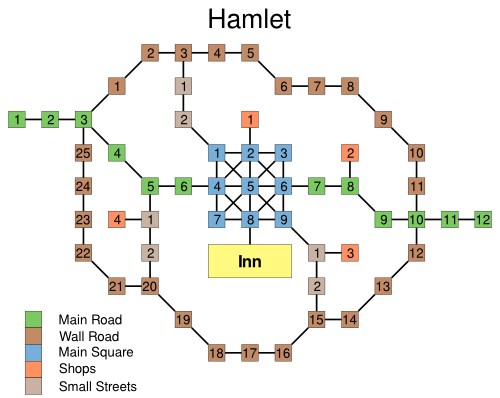
Before we can start creating anything in-game, we first need to decide the layout of our hamlet. This means deciding how big it will be, and what roads, streets, squares, buildings, and other features will be present.
The map below shows the layout of the hamlet. The hamlet is built along a main road which runs through the centre of the town. The main square in the town is dominated by a large inn. There is a small, low stone wall that surrounds the hamlet and a road winds its way around the inside of the wall. There are a few small streets connecting the main road to the square and the encircling road. A few shops are present in the town, too.

At this point, the design of the inn and the nature of the shops has not been decided. The inn will probably be a large building, with at least 2 levels and probably a basement. There will probably be a quest or two in the inn to make things interesting.
Now that we have decided the layout of the hamlet, we need to decide how things
will be arranged in terms of files and directories for the rooms and code.
First, though, we should make a directory to contain everything related to the
hamlet. This can be done using the online editor by right-clicking on an
existing directory and selecting 'New directory' or by using the mkdir
command on the mud.
I will create my directory in /home/tristan/samples/hamlet:
> cd /home/tristan/samples > mkdir hamlet > ls /home/tristan/samples: hamlet 1 entry.
Even though the hamlet is a fairly small town, it is still a good idea to break it up into smaller areas by using sub-directories. This becomes especially important when creating larger areas. For the hamlet, we'll split things up by road.
> cd hamlet > mkdir main_road > mkdir main_square > mkdir wall > mkdir streets > mkdir shops > mkdir inn > ls /home/tristan/samples/hamlet: inn main_square streets main_road shops wall 6 entries.
The inn gets its own directory because we expect it to be fairly large. The smaller streets share a directory, as do the shops.
Now that we've got everything ready, we can continue on to part two.